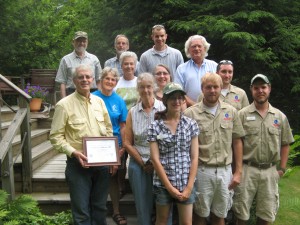by Dr. Douglas Johnson

Regional Inlet Invasives Plant Program volunteers are, front to back, from left, Jennifer Breen; Doug Johnson, Evelyn Greene, Michael Bicknell, EJ Borchert; Ellen Collins, Elizabeth Mangle, Eric Paul; Terry DeArmas, Avery Menz; Bob Manning, Roy Keats, Brendan Quirion.Courtesy photo.
Efforts to control Japanese Knot-weed in the Adirondacks continue to make great strides. On July 1, fifteen people met to discuss plans for 2012.
The Regional Inlet Invasive Plant Program (RIIPP), which started in 2008, has expanded treatment areas each year since, with a long-term goal of eradicating Japanese Knotweed throughout the Adirondacks.
In 2011 about 75,000 knotweed canes were injected and thousands more sprayed with herbicide (glyphosate) in over 150 sites including Big Moose, Blue Mountain Lake, Eagle Bay, Indian Lake, Inlet, Lake Piseco, Lake Placid, Long Lake, Old Forge, North River, Saranac Lake, Speculator, and Wells.
In 2012, RIIPP will continue efforts in those towns and expand to Cranberry Lake, Garnet Lake, and Tupper Lake, coordinating efforts with those of the Adirondack Park Invasive Plant Program (APIPP) and the HCWSCD
Japanese knotweed forms dense thickets of thick bamboo-like hollow stems, with mature heights over 10 feet and an extensive network of underground roots. The leaves are somewhat heart-shaped with white lacy flowery clusters that form in August.
We recommend not cutting knotweed at all, or not after June 1st, so there is enough growth to allow effective herbicide application in August/September.
Digging the plant/roots is not recommended since tiny root fragments can start new plants.
Treatment with herbicide (glyphosate) done properly is very effective. Treatment of sites near rivers and streams is important to prevent downstream spread of knotweed.
The program has been very successful. Knotweed has been eradicated at many sites, and should be eradicated at many others in the next few years. The community has pitched in, with volunteers identifying sites and obtaining property owner permissions.
Invasive plant coordinators include Ellen Collins (Blue Mountain Lake), Terry DeArmas (Indian Lake), Patty Wittmeyer (Inlet, Eagle Bay), Larry Master (Lake Placid), Chuck Taylor (Long Lake), Judy Brown and Evelyn Greene (North Creek, North River), Roy Keats and Bob Manning (Garnet Lake), Katy Weil (Lake Piseco), and Leslie Karasin (Saranac Lake).
Paul Smith Lake Stewards helping in 2012 include Eric Paul (Cranberry Lake, Star Lake), Michael Bicknell (Stillwater Reservation), Jennifer Breen (Forestport to Fourth Lake), and EJ Borchert (Long Lake, Tupper Lake). Elizabeth Mangle discussed HCWSCD efforts.
Applicators Ryan Burkum and Avery Menz discussed last year’s treatments and plans for 2012. Patty Wittmeyer, Inlet Town Clerk, and myself, a summer resident of 7th Lake, are coordinating efforts.
Brendan Quirion described APIPP’s plans including control of other invasive plants and training sessions for how property owners can effectively use herbicides including one August 21st at the Zoning Office Board Room in Old Forge from 1 to 3 p.m. Sessions are free. and interested persons are asked to RSVP by July 9th to Sarah Walsh at (518) 576-2082, ext. 119 or: sarah_walsh@tnc.org.
There is no cost to property owners for the herbicide applications. Many have helped with donations, and in 2011 and 2012 RIIPP received $10,000 grants from APIPP. Additional volunteers and tax-deductable donations are needed.
Donations should be made payable to: Town of Inlet, Invasive Plant Control Fund; and mailed to Town of Inlet, P.O. Box 179, Inlet NY 13360.
Check out www.noknot
weed.org, which includes a slide show and provides detailed information for property owners, volunteers, and how to treat knotweed.
